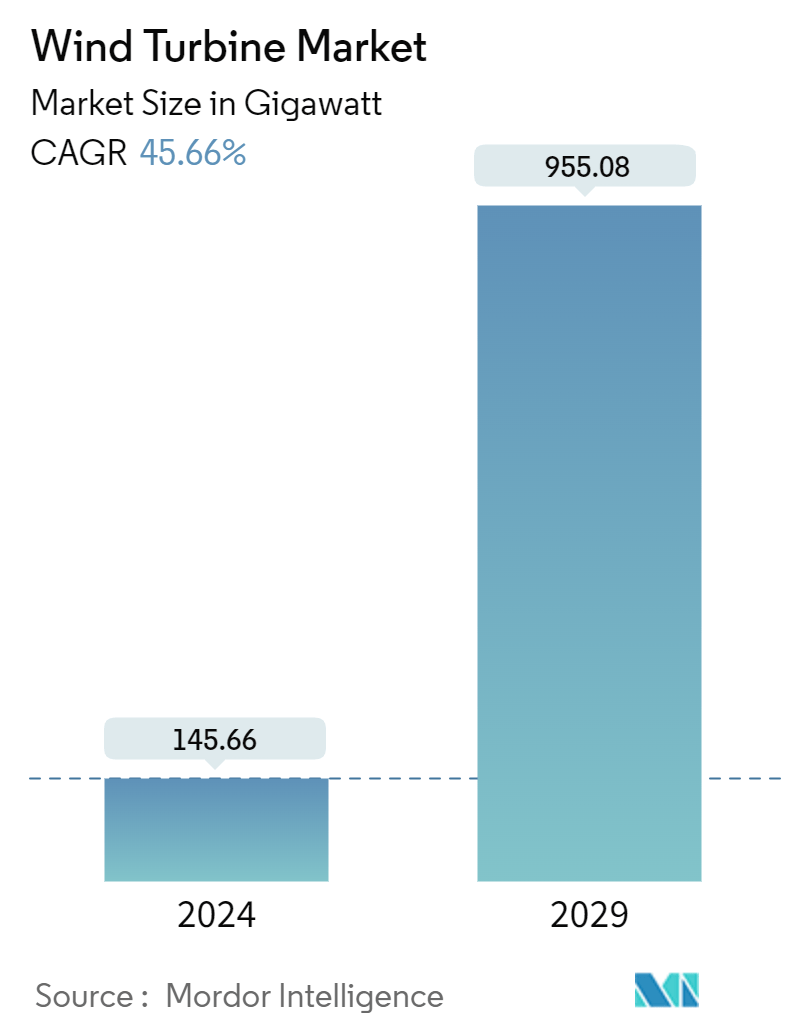Market Size of Wind Turbine Industry

| Study Period | 2019 - 2029 |
| Base Year For Estimation | 2023 |
| CAGR (2024 - 2029) | 45.66 % |
| Fastest Growing Market | Asia Pacific |
| Largest Market | Asia Pacific |
| Market Concentration | Medium |
Major Players
*Disclaimer: Major Players sorted in no particular order |
Wind Turbine Market Analysis
The Wind Turbine Market size is estimated at 145.66 gigawatt in 2024, and is expected to reach 955.08 gigawatt by 2029, growing at a CAGR of 45.66% during the forecast period (2024-2029).
- Over the medium period, factors such as increasing demand for renewable energy sources, especially wind power, in the power generation mix, efforts to reduce the reliance on fossil fuel-based power generation, and regulations on energy efficiency are expected to drive the wind turbine industry growth.
- On the other hand, the adoption of alternative clean energy sources like solar and other alternatives is likely to hinder the market growth and affect wind turbine market share.
- The market forecast report reveals that the Global Wind Energy Council committed to achieving 380 GW of offshore wind by 2030 and 2,000 GW by 2050 worldwide, which is likely to provide significant opportunities for the deployment of wind turbines soon.
- The Wind turbine industry analysis report indicates that Asia-Pacific is expected to be the largest and fastest-growing market, owing to the largest market share in terms of wind power generation and the presence of manufacturing and technology hubs in countries like China, India, Japan, etc.
Wind Turbine Industry Segmentation
Wind turbines are a growing source of intermittent renewable energy, and they are employed in many nations to minimize energy costs and reliance on fossil fuels.
The wind turbine market is segmented by location of deployment, capacity, and geography. By location of deployment, the market is segmented into onshore and offshore. By capacity, the market is segmented into small, medium, and large. The analysis report also covers the market size and growth forecast for the wind turbine market across major regions, such as Asia-Pacific, North America, Europe, South America, and the Middle East and Africa.
For each segment, the industry size and forecasts are provided based on installed capacity (GW) and are extensively outlined in the report PDF.
| Location of Deployment | |
| Onshore | |
| Offshore |
| Capacity | |
| Small | |
| Medium | |
| Large |
| Geography | |||||||||||
| |||||||||||
| |||||||||||
| |||||||||||
| |||||||||||
|
Wind Turbine Market Size Summary
The wind turbine market is poised for substantial growth over the forecast period, driven by the increasing demand for renewable energy sources, particularly wind power, as part of the global shift towards sustainable energy solutions. This growth is supported by efforts to reduce dependence on fossil fuels and enhance energy efficiency, alongside regulatory frameworks promoting clean energy adoption. The market is expected to experience significant expansion, with offshore wind energy emerging as a key area of investment due to advancements in technology, declining costs, and substantial developments in offshore projects worldwide. The commitment by the Global Wind Energy Council to significantly increase offshore wind capacity by 2030 and 2050 further underscores the potential for wind turbine deployment.
Asia-Pacific is anticipated to be the largest and fastest-growing market, driven by the region's abundant wind energy resources and the presence of manufacturing and technology hubs in countries like China, India, and Japan. These countries are actively pursuing widespread deployment of wind energy, supported by government incentives and advancements in turbine technology. The region's focus on sustainable development and reducing greenhouse gas emissions has made offshore wind energy a mainstream power generation source. The market is moderately fragmented, with major players such as Vestas Wind Systems, Siemens Gamesa Renewable Energy, and General Electric Company leading the charge in expanding wind turbine installations globally.
Wind Turbine Market Size - Table of Contents
-
1. MARKET OVERVIEW
-
1.1 Introduction
-
1.2 Wind Turbine Installed Capacity and Forecast in GW, till 2029
-
1.3 Recent Trends and Developments
-
1.4 Government Policies and Regulations
-
1.5 Market Dynamics
-
1.5.1 Market Drivers
-
1.5.1.1 Increasing Demand for Renewable Energy Sources
-
1.5.1.2 Efforts to Reduce the Reliance on Fossil Fuel-Based Power Generation
-
-
1.5.2 Market Restraints
-
1.5.2.1 The Adoption of Alternative Clean Energy Sources
-
-
-
1.6 Supply Chain Analysis
-
1.7 Porter's Five Forces Analysis
-
1.7.1 Bargaining Power of Suppliers
-
1.7.2 Bargaining Power of Consumers
-
1.7.3 Threat of New Entrants
-
1.7.4 Threat of Substitute Products and Services
-
1.7.5 Intensity of Competitive Rivalry
-
-
-
2. MARKET SEGMENTATION
-
2.1 Location of Deployment
-
2.1.1 Onshore
-
2.1.2 Offshore
-
-
2.2 Capacity
-
2.2.1 Small
-
2.2.2 Medium
-
2.2.3 Large
-
-
2.3 Geography
-
2.3.1 North America
-
2.3.1.1 United States
-
2.3.1.2 Canada
-
2.3.1.3 Rest of the North America
-
-
2.3.2 Europe
-
2.3.2.1 Germany
-
2.3.2.2 United Kingdom
-
2.3.2.3 France
-
2.3.2.4 Spain
-
2.3.2.5 Russia
-
2.3.2.6 NORDIC
-
2.3.2.7 Italy
-
2.3.2.8 Turkey
-
2.3.2.9 Rest of the Europe
-
-
2.3.3 Asia-Pacific
-
2.3.3.1 China
-
2.3.3.2 India
-
2.3.3.3 Japan
-
2.3.3.4 Australia
-
2.3.3.5 Thailand
-
2.3.3.6 Vietnam
-
2.3.3.7 Malaysia
-
2.3.3.8 Indonesia
-
2.3.3.9 Rest of the Asia-Pacific
-
-
2.3.4 South America
-
2.3.4.1 Brazil
-
2.3.4.2 Argentina
-
2.3.4.3 Colombia
-
2.3.4.4 Rest of the South America
-
-
2.3.5 Middle East and Africa
-
2.3.5.1 United Arab Emirates
-
2.3.5.2 Saudi Arabia
-
2.3.5.3 South Africa
-
2.3.5.4 Egypt
-
2.3.5.5 Qatar
-
2.3.5.6 Nigeria
-
2.3.5.7 Rest of the Middle East and Africa
-
-
-
Wind Turbine Market Size FAQs
How big is the Wind Turbine Market?
The Wind Turbine Market size is expected to reach 145.66 gigawatt in 2024 and grow at a CAGR of 45.66% to reach 955.08 gigawatt by 2029.
What is the current Wind Turbine Market size?
In 2024, the Wind Turbine Market size is expected to reach 145.66 gigawatt.

